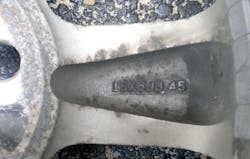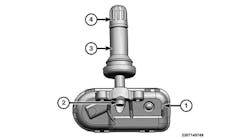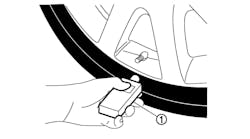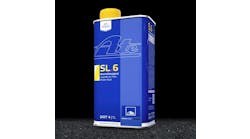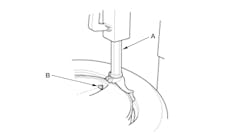One of the most common modifications your customers make to their cars is to replace the wheels. It’s easy to see why — there is really no faster, more effective way to customize a car’s look or feel than by changing the wheels. Whether your customers are upsizing to 18-inch high-performance wheels for a “sporty” look and feel, going all out with those 20-inch or larger “bling” wheels, or downsizing to smaller wheels for a set of snow tires, there are three factors that consumers and service professionals must take into account when choosing and installing a different size of wheel.
1. There is the question of tire size. When you are changing the size of the wheels, the overall diameter of the tire and wheel assembly must remain the same to keep the proper speedometer and odometer settings. For example, when you mount and balance wheels that are an inch larger than the originals, the profile of the new tires must be an inch smaller in order to keep the same diameter, and vice versa for downsizing. This process is known as “plus-one” or “minus-one” sizing.
2. The wheel must be the correct and approved width for the size of tire that it will carry. The chart of approved wheel widths for tire sizes is available in the “Ultimate Wheel & Tire Plus Sizing Guide” and the “Tire Guide,” and online in many places.
3. Perhaps the most important factor in choosing and installing new wheels is the proper handling of wheel offset. Offset also can be one of the most difficult factors to get right when replacing wheels. It’s a concept that is often very difficult for customers to understand, and can be an enormously difficult concept for service professionals to explain. However, it is important to get it right, because getting the offset wrong risks badly damaging the replacement wheels and tires as well as suspension components, and can put the driver at serious risk of a blowout.
Any of these factors, if mishandled, can severely affect your reputation, not to mention cut down on repeat business!
[PAGEBREAK]
What is offset?
Put as simply as possible, wheel offset is the distance, expressed in millimeters, between the mounting plate — the surface of the wheel that mates against the rotor when installed — and the centerline of the wheel — the line running around the wheel’s barrel, which determines the center of its width.
Positive offset means that the mounting plate is in the outside half of the wheel, toward the wheel face. Most OEM wheels, and most wheels in general, will have a positive offset.
Negative offset means the mounting plate is on the other side of the wheel’s centerline, farther toward the suspension. Negative offset is generally seen in very deep-dish or deep convex aftermarket wheels.
The particular offset, therefore, determines how the wheel will sit in the car’s wheel well, and how much of the barrel will extend toward the suspension. While most aftermarket wheels are made in multiple offsets, most OEM wheels only come in the offset that is correct for the specific car for which they are made.
Closely related to offset is the concept of backspacing. Offset and backspacing are often spoken of as if they are the same thing, but they are very different. Backspacing is defined as the distance between the mounting plate and the inner flange of the wheel. Backspacing is, therefore, the combination of the offset and the wheel width. This comes into play if the new wheels are wider than the old, as the offset may need to change to compensate for the greater width.
The perils of bad offset
If you get the offset or backspacing wrong when you are procuring and installing new wheels for a customer, you run the very real risk of having the wheel sit too far inside the wheel well, causing the inner edge of the wheel and tire to rub against the suspension. Wheel rub is bad enough, as it will damage the inner flange of the wheel and probably the suspension components it’s rubbing against. Tire rub is even worse, as it will very quickly rip up the inside sidewall of the tire, an area where the damage is very hard to detect until the tire blows out.
This is why that ideally, you don’t want the new offset to be more than 5 millimeters away from the old offset in either direction. However, this isn’t always possible. What you do need to keep in mind is that more negative offset, i.e., an offset that is less than the original, will push the wheel out farther from the wheel well. Usually, this will not cause a problem, although it might result in a pretty funky look.
[PAGEBREAK]
In contrast, too much positive offset is a danger, as it will push the wheel farther in toward the suspension. Here’s an extreme example: If you have to go from a 45 mm offset to a 20 mm, the wheels will protrude from the sides of the car. But going from a 20 mm to a 45 mm offset not only may destroy the tires, but also has the potential of affecting vehicle control and injuring the customer — not an optimal customer service outcome!
How to find the car’s offset
Finding the actual offset designed into the car is key to the whole process of matching new wheels. Even when your customer is looking to put OEM wheels from a different model by the same maker onto his or her car, you cannot count on the offset being the same.
BMW in particular is notorious for having a dizzying variety of different offsets across its model lines. If you ever try to put M5 wheels on an M3, for example, you’re courting disaster. Some cars will even have different offsets for front and rear axles; BMW again being notorious for this.
Most cars have their offset data printed in the “Tire Guide” for the car’s particular year, but you can also try a website that I recently found while researching tire size calculators.
WheelSizeCalculator.com gives you an incredible array of useful data for any make and model, including offset, hub diameter, bolt pattern and proper wheel width for each possible tire and wheel size. The site also boasts an enormously useful Match Calculator, which will give a list of other possible wheel fitments for any given model.
Although the Match Calculator will give many matches where the offset discrepancy is clearly unacceptable, it is fantastic for determining what other OEM wheels might fit on your customer’s car, and weeding out those fitments in which the offset is wrong. It’s an amazing tool that I really wish I had known about when I was selling wheels.
How to find the wheel’s offset
Most wheels will have their offset embossed on the back of the wheel, either on the mounting plate itself or on the back of one of the spokes. Offset data usually, but not always, ends with the letters “ET” (which means the same thing as offset); a 45 mm offset will be printed as either ET45 or 45ET. If the offset is not printed, as with unmarked aftermarket wheels whose history is unknown, measure the offset yourself. The easiest way I know of to do this is to determine the wheel’s centerline and tape a piece of string to the inner barrel at that point.
Place the wheel on its flanges on a flat surface, and put a paperclip on the string to make it hang straight. Then place a ruler flat against the mounting plate and see where the string crosses the ruler. Measuring backspacing is, of course, much easier, as it only requires a ruler and a straightedge across the back edge of the wheel.
[PAGEBREAK]
Offset spacers
Offset spacers are metal shims drilled with a bolt pattern designed to compensate for too much positive offset by fitting between the wheel and the rotor to push the wheel farther away from the suspension (it’s impossible to compensate for too much negative offset). It is better to install the correct size and offset wheel in the first place, but if you must use spacers, ensure that they are hub-centric, meaning that they fit precisely over the car’s axle hub and precisely inside the wheel hub, as it is this connection that actually holds the weight of the car. It’s also usually necessary to use longer lug bolts or lug studs to install the wheels.
Test fitting
If you are at all unsure of correct offset or backspacing, it’s best to test-fit the wheels before installing. Put a wheel on the front and back axles — remember that front and rear offsets can be different — and tighten the lug nuts by hand.
You will also want to ensure that there is plenty of clearance for the tire when it goes on. At least an inch of clearance is probably best to ensure that tire flex or suspension travel doesn’t cause a problem.
It’s even better to test-fit the entire wheel and tire assembly to completely ensure proper fit, but as most new tires are not returnable once mounted, this is not always possible.
Conclusion
In summary, here are a few important points to remember about wheel offset.
• If the new wheels are the same width, the new offset should ideally be within 5mm of the old offset in either direction. If offset must be substantially different, avoid using more positive offset at all costs.
• If the new wheels are wider, backspacing must be calculated. The offset on the new wheels may need to be less to counteract the extra width.
• Offset must be carefully checked even if you are putting on different OEM wheels from the same maker.
Getting the wheel offset right will not only keep your customers happy and safe, but also help to convince customers that you are careful and know what you’re talking about when it comes to their wheels. That’s good for your customers and good for your business. ■
Sean Phillips repaired, sold and installed wheels and tires for more than 10 years as the former operations manager at Rim and Wheel Works in Waltham, Mass. Read his blogs about “Tires and Wheels” on About.com.
For more 2013 Performance Handbook articles, see:
Performance tire sales: From 50 years ago to 25 years ago to now
